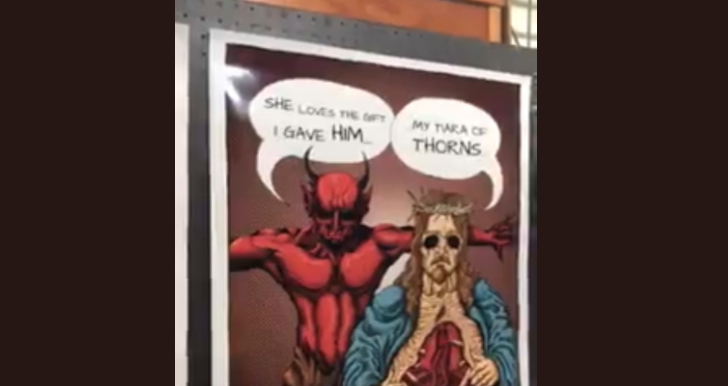An uproar over recently exhibited artwork from a student at a KwaZulu-Natal-based Curro School has lead to many opinions over whether the work is really “satanic” or if the student’s deeper meaning has been overlooked in the midst of the outrage.
The scandal started when a Richards Bay pastor, Andrew Anderson, called out the school in a video over what he called “demonic and satanic” art that he felt was not appropriate to be exhibited at the school that claims to “uphold Christian values”.
Many of the artwork pieces by the student feature religious themes that have been edited to include a figure resembling Ronald McDonald. ‘Demonic figures’ are also featured in works depicting the Last Supper and The Creation of Adam. Paper-mâché sculptures of horned creatures were created using pages torn from the Bible.
“I am so upset, I am not emotional, I am upset. I walked into the school, into the school hall and there is some artwork being displayed from the matrics,” explains Anderson. “I couldn’t stand in here because it felt like they were crucifying Jesus all over again.”
Following news of the outrage, the student released an official statement to share their side of the story and explain the idea behind the works.
In the statement, the student mentions how the recording of their work was non-consensual and, following the magnitude of the controversy resulting from the recording, they have decided to release a statement giving more information about the concept that inspired the works.
“Despite what the parent depicted in the recording purports my artwork to be, the rationales seen nearby each piece in the video quite clearly explain that they are the furthest thing from so-called ‘satanism’. For the sake of brevity, I will summarise the concepts explored by my artworks in this single rationale,” writes the student.
The student goes on to explain how the works exhibited explore and address the commercialisation of contemporary organised religion and the monetary exploitation of faithful individuals by the greedy, disguised by church-like institutes.
“They discuss (through the appropriation of religious imagery) how contemporary religion has become superficial. Instead of connecting with one’s faith on a deep, seemingly meaningful level and actually having the guts to ask metaphysical questions, many simply consume their religion in the same fashion as they would any other product (hence the use of Ronald McDonald as a symbol for the infection of faith with consumer culture) and it is because of this that they become vulnerable to manipulation at the hands of those who use their office as a religious leader to further their own lives instead of bringing about positive change in the world,” the student adds.
They go on to explain how Ronald McDonald was not used as an act of defamation of anyone’s messiah but instead as a symbol of the abuse and misuse thereof.
“I do not care what people believe, I simply want to highlight potential risks in how they believe it. For in a society dominated by an idea-driven culture, the contents of your mind are perhaps the most important and exploitable. In a country (and indeed larger world) that is stricken with poverty and glaring inequalities, who can take those religious leaders who rake in millions of rands of income on a regular basis seriously? Who can honestly say that it is right for certain religious leaders to have gotten away with robbing those who trust them most and not repaying society? Televangelism, church- sponsored merchandise and even charging a fee for attendance are all minor examples of the ways in which one contributes to the modern-day business of religion,” adds the student.
The drawings take the compositions of classical and religious painting with symbols of capitalism represented within them to communicate this sentiment. Famous pieces like “The Creation of Adam”, “Alba Madonna”, “The Last Supper”, “The Dead Christ Mourned (‘The Three Maries’)” and “The Last Judgement” were appropriated to communicate this idea.
“However unsettling the imagery may seem, it is designed to provoke thought – to make the viewer question whether they are subject to merciless exploitation or are truly cognisant of what and how they believe. All other sentiments expressed in the exhibition stem from this one. Questions of rationality and irrationality, good and evil as well as an introspective reflection on my own metaphysical beliefs are all discussions pursued in my art and are sadly things forgotten and ignored by those too scared by the honesty and power of artistic expression to see my work for what it is – a dissection of contemporary faith,” the student comments.
The student ends their statement in the hopes that those who read it will realise that their work is a far cry from “satanic panic” like some people have claimed and that they were not created from a place of malice or to reflect the views of the school they attend or any religions.
“I really could not care what any one person believes (nor should anyone) but what I do care about is fairness and the sanctity of the human mind. Therefore, it is for that reason that I denounce the completely unfounded claims made against my art on social media and advise that before anyone speak, that they perhaps think. I cannot damage that which has already been shattered,” concludes the statement.
Picture: Twitter

